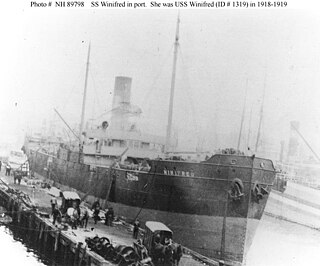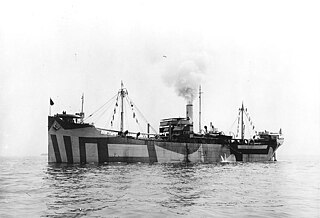
The second USS Absecon (AVP-23) was a United States Navy Barnegat-class seaplane tender in commission from 1943 to 1947, converted during construction to serve as a catapult training ship during World War II. The ship was in commission in the United States Coast Guard as the cutter USCGC Absecon (WAVP-374), later WHEC-374, from 1949 to 1972. Transferred to South Vietnam in 1972, she served in the Republic of Vietnam Navy as the frigate RVNS Pham Ngu Lao (HQ-15) until she was captured by North Vietnam at the conclusion of the Vietnam War in 1975. After that, she served in the Socialist Republic of Vietnam's Vietnam People's Navy as PRVSN Pham Ngu Lao (HQ-01).
Two ships of the United States Navy have been named Absecon, after Absecon Inlet, located north of Atlantic City, New Jersey:

USS Wabash (ID-1824) was a German cargo ship, impounded in the neutral United States when World War I commenced. Once the United States entered the war, the ship was confiscated and turned over to the U.S. Navy for wartime use as USS Wabash.

USS Federal was a freighter acquired by the U.S. Navy during World War I. She was completed at the end of the war and supplied Allied troops in Europe with food and horses, and, on return trips to the United States, brought troops back home. After three round transatlantic trips in supporting the troops, she was returned to the U.S. Shipping Board, which eventually sold her in 1937. She then became the British freighter Federlock which was captured in 1941 by the Japanese, who renamed the ship the Hakusan Maru. The ship sailed carrying Japanese cargo until sunk by an American submarine in 1945.

USS Santa Clara (ID-4523) was a Santa Cecilia-class freighter for the United States Navy during World War I. In service for the United States Army she was known as USAT Santa Clara. Both before and after her World War I service she was known as SS Santa Clara for the Grace Line.

Wakulla was a steam cargo ship built in 1918-1919 by Los Angeles Shipbuilding & Dry Dock Company of San Pedro for the United States Shipping Board as part of the wartime shipbuilding program of the Emergency Fleet Corporation (EFC) to restore the nation's Merchant Marine.

The Barnegat class was a large class of United States Navy small seaplane tenders (AVP) built during World War II. Thirty were completed as seaplane tenders, four as motor torpedo boat tenders, and one as a catapult training ship.

Absecon Inlet is a narrow strait on the southeastern coast of New Jersey in the United States.

USS Edgar F. Luckenbach (ID-4597) was a cargo ship and troop transport that served in the United States Navy from 1918 to 1919.

USS Winifred (ID-1319) was a cargo ship and tanker that served in the United States Navy from 1918 to 1919.

USS Suwanee (ID-1320) was a United States Navy transport in commission in 1919. She was the second ship to carry her name.

USS Buena Ventura (ID-1329), also spelled USS Buenaventura, was a United States Navy cargo ship in commission in 1918 that was sunk during World War I.

USS Arizonan (ID-4542A), also written ID-4542-A was a United States Navy cargo ship and troop transport in commission from 1918 to 1919.

USS Aniwa (ID-3146) was a steel-hulled, single-screw freighter that served in the United States Navy from 1918 to 1919.

USS M. J. Scanlon (ID-3513) was a United States Navy cargo ship in commission from 1918 to 1919.

SS Santa Paula was a freighter of the Grace Line and later the American-Hawaiian Steamship Company. The vessel also saw military transport service during both World Wars.

USS Westover (ID-2867) was a cargo ship of the United States Navy that served during World War I and was sunk during her maiden voyage.

USS Western Hope (ID-3771) was a cargo ship of the United States Navy that served during World War I and its immediate aftermath.`

USS Westpool (ID-3675) – sometimes written as West Pool – was a cargo ship of the United States Navy that served during World War I and its immediate aftermath. As SS Westpool, she was sunk during World War II after being sold to the United Kingdom for use as a merchant ship.

USS St. Francis (ID-1557) was a freighter built for the Isthmian Steamship Company, of London, England, a subsidiary of United States Steel Corporation, prior to World War I. She was acquired by the US Navy for use during the war.



















